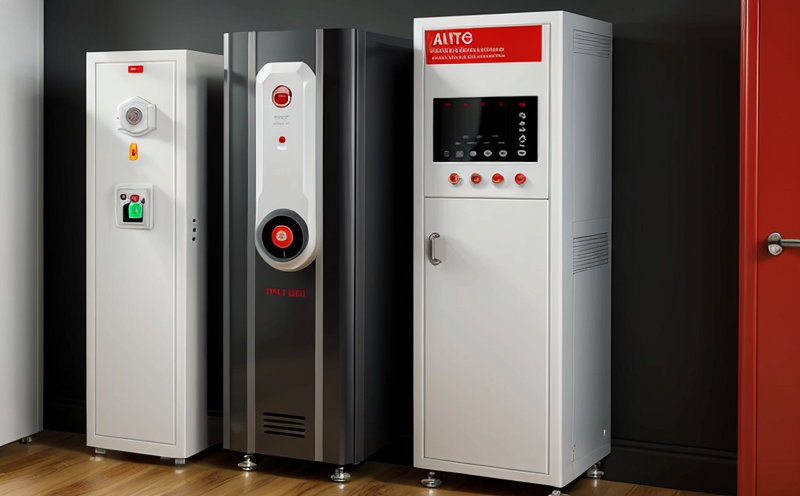Smoke Chamber Testing of Detectors
The smoke chamber testing of fire detection and alarm devices is a critical procedure to ensure that detectors function reliably under defined conditions. This test evaluates the performance, sensitivity, and response time of smoke detectors when exposed to controlled levels of smoke. The process involves placing the detector in a precisely regulated environment where smoke concentration can be systematically increased until the device triggers an alarm.
This testing is essential for ensuring compliance with various fire safety regulations and standards such as NFPA 72, ISO 8479, and IEC 60531. It helps in identifying potential issues before they lead to costly failures or hazards. The test setup typically includes a smoke chamber with precise control over temperature, humidity, and air flow to simulate real-world conditions.
Smoke detectors are the first line of defense against fire outbreaks. They provide early warnings that can help prevent fires from spreading, reduce property damage, and save lives. By subjecting these devices to controlled environments through smoke chamber testing, we ensure they perform as expected in critical moments.
The methodology involves placing a detector within a sealed chamber where smoke is introduced gradually or abruptly depending on the test requirement. The smoke concentration is then measured using calibrated instruments like aspirators and photometers. The detector's performance is evaluated based on its ability to trigger an alarm at specified levels of smoke density.
During the testing process, various parameters are monitored including temperature fluctuations within the chamber, humidity levels, and air velocity. These factors can significantly impact a detector’s responsiveness. For instance, higher temperatures may reduce sensitivity while lower pressures might affect airflow patterns affecting detection accuracy.
Understanding these nuances is crucial for accurate assessments. Compliance officers need to be aware of such details when interpreting test results. R&D engineers benefit greatly from this type of testing as it provides valuable insights into how design changes could improve product performance or reliability under extreme conditions.
In summary, smoke chamber testing plays a vital role in maintaining public safety by ensuring that fire detection systems work correctly and efficiently. This service ensures that every component meets stringent regulatory requirements before deployment into operational environments.
Applied Standards
| Standard | Description |
|---|---|
| NFPA 72: National Fire Alarm and Signaling Systems Code | This standard provides guidelines for the design, installation, maintenance, and testing of fire alarm systems. It ensures that all components function correctly during emergencies. |
| ISO 8479: Smoke Detectors - Determination of Sensitivity | This international standard defines methods for determining the sensitivity levels at which smoke detectors activate alarms under controlled conditions. It helps manufacturers and users understand performance metrics. |
| IEC 60531: Fire Detection Systems - Performance Testing | An IEC standard that specifies procedures for assessing the overall functionality of fire detection systems, including smoke chamber tests. It ensures interoperability and compatibility among different brands. |
Scope and Methodology
The scope of smoke chamber testing includes evaluating the sensitivity, response time, and overall performance of smoke detectors under controlled environmental conditions. The methodology involves several key steps:
- Setting up the smoke chamber with precise control over temperature, humidity, and air flow.
- Introducing smoke into the chamber at predefined rates until the detector triggers an alarm.
- Maintaining consistent conditions throughout the test to ensure reliability of results.
The process also involves calibration of instruments used for measuring smoke concentration and other relevant parameters. Compliance officers should ensure that all equipment is properly calibrated before each test run. R&D engineers can use these tests to fine-tune designs, while procurement professionals may leverage this information when selecting suppliers.
Testing typically follows a structured approach where different scenarios are simulated to challenge the detector's limits. This ensures comprehensive evaluation of its capabilities across various operating conditions. The results provide valuable data for continuous improvement and compliance verification.
Use Cases and Application Examples
- Facility Management: Ensuring that fire detection systems are up-to-date with current regulations is crucial. Smoke chamber testing helps facilities maintain compliance and prepare for potential inspections.
- R&D Engineers: This type of testing allows engineers to experiment with new materials or designs without risking real-world hazards. It provides them with essential feedback on product performance.
- Compliance Officers: By conducting regular smoke chamber tests, compliance officers can verify that all equipment meets regulatory requirements and is ready for deployment in public spaces.





